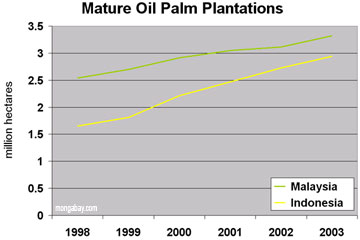Massive oil palm expansion planned by Indonesia’s richest man
Massive oil palm expansion planned by Indonesia’s richest man
mongabay.com
May 8, 2007
Indonesia’s richest man plans to spend $4 billion to expand his company’s palm oil, energy, and pulp and paper holdings, according to a report from Reuters.
Sukanto Tanoto, head of RGM International and worth an estimated $2.8 according to Forbes magazine, said that he will build a biodiesel plant in Sumatra to process palm oil.
“Palm oil is like green gold now,” Reuters quoted him as saying. “This is a global issue, the balance between food production and fuel production. As long as the (crude) oil price is above $60 and there are concerns about global warming, it will be big.”

Oil palm cultivation has increased from 186,744 hectares in Sabah and Sarawak (Malaysian Borneo) in 1984 to 1,673,721 hectares at the close of 2003. In Kalimantan (Indonesian Borneo), oil palm has expanded even faster: from 13,140 hectares in 1984 to nearly one million hectares at the end of 2003. |
Environmentalists say that clearing for oil palm plantations is rapidly destroying Indonesia’s biodiverse rainforests. Some have called for a ban on palm oil unless is it proven to come from sustainable sources. Last week the Dutch government said it would seek to promote environmentally-friendly oil palm cultivation in Indonesia through a voluntary certification program.
Oil palm is the most productive oil seed in the world. A single hectare of oil palm may yield 5,000 kilograms of crude oil, or nearly 6,000 liters of crude, making the crop remarkably profitable when grown in large plantations — one study that looked at 10,000 hectare-plantations suggests an internal rate of return of 26 percent annually. As such, vast swathes of land are being converted for oil palm plantations. Oil palm cultivation has expanded in Indonesia from 600,000 hectares in 1985 to more than 6 million hectares by early 2007, and is expected to reach 10 million hectares by 2010.
Related articles on palm oil (palm oil blog)
Social impact of oil palm in Borneo.
For most of its history Borneo was scarcely populated by humans. The unforgiving climate and dense rainforest kept populations small and scattered. In the past half century this has all changed. The influx of more than half a million transmigrants into Borneo over the past thirty years has doubled the island’s population and created tremendous demand for jobs. Initially the rubber and logging industries provided employment, but when this collapsed in the mid- (Malaysia) to late-1990s (Kalimantan), work opportunities dried up for most of the local population. Despite this, hundreds of new arrivals continued to show up in Borneo on a weekly basis.
Eco-friendly palm oil could help alleviate poverty in Indonesia.
The Associated Press (AP) recently quoted Marcel Silvius, a climate expert at Wetlands International in the Netherlands, as saying palm oil is a failure as a biofuel. This would be a misleading statement and one that doesn’t help efforts to devise a workable solution to the multiplicity of issues surrounding the use of palm oil.
Why is palm oil replacing tropical rainforests?.
In a word, economics, though deeper analysis of a proposal in Indonesia suggests that oil palm development might be a cover for something more lucrative: logging. Recently much has been made about the conversion of Asia’s biodiverse rainforests for oil-palm cultivation. Environmental organizations have warned that by eating foods that use palm oil as an ingredient, Western consumers are directly fueling the destruction of orangutan habitat and sensitive ecosystems. So, why is it that oil-palm plantations now cover millions of hectares across Malaysia, Indonesia, and Thailand? Why has oil palm become the world’s number one fruit crop, trouncing its nearest competitor, the humble banana? The answer lies in the crop’s unparalleled productivity. Simply put, oil palm is the most productive oil seed in the world. A single hectare of oil palm may yield 5,000 kilograms of crude oil, or nearly 6,000 liters of crude.